
The House of Representatives of the Philippines is the lower house of the Congress of the Philippines. Informally known as the Kamara, the lower house is usually called Congress, although the term collectively refers to both houses.
The legislative districts of Agusan del Norte are the representations of the province of Agusan del Norte in the various national legislatures of the Philippines. The province is currently represented in the lower house of the Congress of the Philippines through its first and second congressional districts.
The legislative districts of Zamboanga City are the representations of the highly urbanized city of Zamboanga in the various national legislatures of the Philippines. The city is currently represented in the lower house of the Congress of the Philippines through its first and second congressional districts.
The legislative districts of Agusan del Sur are the representations of the province of Agusan del Sur in the various national legislatures of the Philippines. The province is currently represented in the lower house of the Congress of the Philippines through its first and second congressional districts.
The legislative districts of Basilan are the representations of the province of Basilan in the various national legislatures of the Philippines. The province is currently represented in the lower house of the Congress of the Philippines through its lone congressional district.
The legislative districts of Iligan are the representations of the highly urbanized city of Iligan in the Congress of the Philippines. The city is currently represented in the lower house of the Congress through its lone congressional district.
The legislative districts of Davao City are the representations of the highly urbanized city of Davao in the various national legislatures of the Philippines. The city is currently represented in the lower house of the Congress of the Philippines through its first, second, and third congressional districts.
The legislative districts of Zamboanga del Norte are the representations of the province of Zamboanga del Norte in the various national legislatures of the Philippines. The province is currently represented in the lower house of the Congress of the Philippines through its first, second and third congressional districts.
The legislative districts of Zamboanga del Sur are the representations of the province of Zamboanga del Sur in the various national legislatures of the Philippines. The province is currently represented in the lower house of the Congress of the Philippines through its first and second congressional districts.
The legislative districts of Sulu are the representations of the province of Sulu in the various national legislatures of the Philippines. The province is currently represented in the lower house of the Congress of the Philippines through its first and second congressional districts.
The legislative districts of Davao del Norte are the representation of the province of Davao del Norte in the various national legislatures of the Philippines. The province is currently represented in the lower house of the Congress of the Philippines through its first and second congressional districts.
The legislative districts of Davao del Sur are the representations of the province of Davao del Sur in the various national legislatures of the Philippines. The province is currently represented in the lower house of the Congress of the Philippines through its lone congressional district.
The legislative district of Davao was the representation of the historical province of Davao in the various national legislatures of the Philippines until its dissolution in 1967.
The legislative districts of Cotabato are the representations of the province of Cotabato in the various national legislatures of the Philippines. The province is currently represented in the lower house of the Congress of the Philippines through its first, second, and third congressional districts.
The legislative districts of Lanao del Norte are the representations of the province of Lanao del Norte in the various national legislatures of the Philippines. The province is currently represented in the lower house of the Congress of the Philippines through its first and second congressional districts.
The legislative districts of Lanao del Sur are the representations of the province of Lanao del Sur in the various national legislatures of the Philippines. The province is currently represented in the lower house of the Congress of the Philippines through its first and second congressional districts.
Davao's at-large congressional district may refer to several occasions when a provincewide at-large district was used for elections to the various Philippine national legislatures from the undivided province of Davao.
Davao del Norte's at-large congressional district is an obsolete congressional district that encompassed the entire province of Davao del Norte in the Philippines. It was represented in the House of Representatives from 1968 to 1972 and in the Regular Batasang Pambansa from 1984 to 1986. The province of Davao del Norte was created as a result of the partition of Davao in 1967 and elected its first representative provincewide at-large during the 1969 Philippine House of Representatives elections. Lorenzo S. Sarmiento who served as representative of Davao's at-large congressional district during the partition was this district's first representative. The district remained a single-member district until the dissolution of the lower house in 1972. It was later absorbed by the multi-member Region XI's at-large district for the national parliament in 1978. In 1984, provincial and city representations were restored and Davao del Norte elected three members for the regular parliament. The district was abolished following the 1987 reapportionment to establish three districts under a new constitution.
Davao Oriental's at-large congressional district is an obsolete congressional district that encompassed the entire province of Davao Oriental in the Philippines. It was represented in the House of Representatives from 1968 to 1972 and in the Regular Batasang Pambansa from 1984 to 1986. The province of Davao Oriental was created as a result of the partition of Davao in 1967 and elected its first representative provincewide at-large during the 1967 Philippine House of Representatives special elections. Constancio P. Maglana served as this district's first representative. The district remained a single-member district until the dissolution of the lower house in 1972. It was later absorbed by the multi-member Region XI's at-large district for the national parliament in 1978. In 1984, provincial and city representations were restored and Davao Oriental elected one member for the regular parliament. The district was abolished following the 1987 reapportionment to establish two districts under a new constitution.

Davao del Sur's at-large congressional district is the sole congressional district of the Philippines in the province of Davao del Sur. It was originally created by the 1967 division of the old Davao province and was eliminated following the 1972 abolition of the House of Representatives. The district was restored as a plural member district for the 1984 national parliament known as the Batasang Pambansa but was reconfigured after Davao City gained its own representation. It was eliminated again following the 1987 reapportionment that created an additional district. The district's current configuration dates from 2013 when Davao del Sur lost a seat following the creation of the province of Davao Occidental covering much of its 2nd district. The district is represented in the 18th Congress by Mercedes Cagas of the Nacionalista Party (NP).


